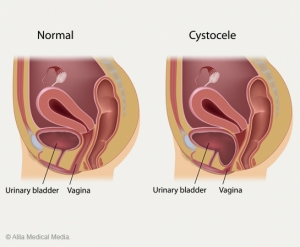 An Overview of a Prolapsed Bladder & Cystocele Repair Surgery
An Overview of a Prolapsed Bladder & Cystocele Repair Surgery
According to Women’s Specialists of Plano, a group of OBGYNs in the Plano, Frisco and Dallas, Texas area, if you are a woman that has delivered multiple children, has experienced a difficult childbirth delivery, or if you have gone through menopause, you may experience the unwanted and frustrating symptoms associated with a cystocele, also referred to as a prolapsed bladder. Pelvic floor dysfunction is a common disorder among both males and females, but even more commonly found in females because of the pelvic and vaginal pressure associated with the above scenarios. In more severe cases, a cystocele repair surgery must be performed in order to eliminate troublesome and unwanted symptoms.
What is a Cystocele?
A cystocele is a pelvic organ prolapse that is explained as the result of a drooping bladder. This condition most commonly affects women between the ages of 50-60. There are many reasons why a woman may experience a prolapsed bladder. A woman’s bladder can droop and cause a cystocele after pushing to deliver children, years of straining to have bowel movements, or heavy lifting over an extended period of time. Another common cause of a cystocele is a previous hysterectomy. Many gynecologists state that when women go through menopause, estrogen begins to naturally decrease within the female body. Estrogen regulates the strength of the muscles around the vagina. When Estrogen is no longer produced these muscles loosen and can lead to a prolapsed bladder.
Symptoms of a Prolapsed Bladder
Many women will have a cystocele and not show symptoms, while others will deal with a variety of unwanted symptoms. Symptoms of a cystocele include:
- Pressure in the vaginal area
- A feeling of fullness in the pelvic region
- Discomfort in the pelvic area when you cough, bend, jump, lift, etc.
- Urinary incontinence ranging from mile to severe
- Bladder infections
- Pain or urinary leakage during sexual intercourse
All of these symptoms will vary depending on the stage and type of cystocele that is presented at diagnosis. There are three types of cystoceles that are classified by their severity.
They are classified as follows:
Grade 1 Cystocele
A grade 1 cystocele will show milder symptoms initially but may worsen if not treated. During this phase the bladder droops just slightly into the vagina causing discomfort and urine leakage. The treatment for this type of cystocele may be rest and recovery, and avoiding heavy lifting or straining which may cause the problem to worsen. Daily exercises of the vaginal muscles through Kegel movements is also recommended.
Grade 2 Cystocele
A grade 2 cystocele is a bit more severe. During this phase the bladder droops until it can be seen through the opening of the vagina causing the complete obstruction of the vagina. This type of cystocele causes major discomfort and severe urinary incontinence. The treatment for this type of cystocele is usually some form of cystocele repair surgery but the cystocele may also be treated with a pessary device.
Grade 3 Cystocele
A grade 3 cystocele is the most severe of cystoceles. This is the diagnosis when the bladder droops low enough to bulge completely out of the vagina. Symptoms are similar to those of a grade 2 cystocele—but worse. Treatment for this type of bladder prolapse is cystocele repair surgery to move the bladder back into its proper place.
Treatment of grade 2 and grade 3 cystoceles are A.) The placement of a pessary device or B.) A cystocele repair surgery to place the bladder back into its place and keep it there.
A Pessary Device is a device that it placed against the uterus inside the vagina to hold the bladder in place. They are made of many types of materials in several different sizes. You and your OBGYN will discuss which is right for you, how to remove and replace it, and the proper procedures for cleaning it. A pessary must be removed on a regular basis to avoid infection or any other complications. Many women are fitted for a pessary device and yield very positive results.
The Need for Cystocele Repair Surgery
Some women will require cystocele repair surgery for the treatment of their prolapsed bladder. In this repair, surgery sutures are used to reattach the fascia thus giving enough support to allow the bladder to remain in place. Patients receiving this surgery should be prepared to stay in the hospital for several days and take 4-6 weeks to fully recover. This surgery is very successful in replacing the bladder thus eliminating the cystocele. The surgery can be performed through open and laparoscopic techniques depending on the grade and severity of the defect. The percentage of recurring cystoceles is very small after a cystocele repair surgery.
If you are suffering from discomfort and urinary leakage or incontinence do not assume it could be the result of age, you need to see your doctor. In the early stages, cystocele treatments are minimally invasive and maximally effective.
Contact the Plano, Frisco and Dallas, Texas area group of OBGYNs from Women’s Specialists of Plano to learn more about a prolapsed bladder, to to discuss cystocele repair surgery in more detail.
